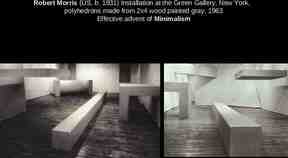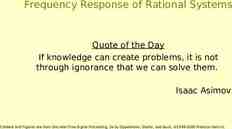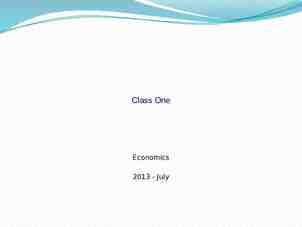Chapter 3 The Constitution Sections 1 and 2 The Constitution and the
21 Slides5.95 MB
Chapter 3 The Constitution Sections 1 and 2 The Constitution and the Three Branches of Government
The U.S. Constitution Outlines the U.S. government Establishes the ruling principles of that government Contains only 7,000 words EMC Publishing, LLC
Parts of the U.S. Constitution Section Purpose Preamble Introduces reasons for creating the document Article I Outlines the legislative branch Article II Outlines the executive branch Article III Outlines the judicial branch Article IV Discusses relations between the states and between the states and the national government Article V Describes how to amend the Constitution Article VI Declares the Constitution to be the supreme law of the land Article VII Lists requirements for ratifying the Constitution 27 amendments Modify the Constitution EMC Publishing, LLC
Basic Principles of the U.S. Constitution There are five basic principles of the U.S. Constitution: Limited government Popular sovereignty Federalism Separation of powers Checks and balances These principles resulted from agreements and debate of the Constitutional Convention, 1787. EMC Publishing, LLC
Your Turn “But when a long train of abuses and usurpations, pursuing invariably the same Object evinces a design to reduce them [the people] under absolute Despotism, it is their right, it is their duty, to throw off such Government.” (Declaration of Independence, 1776) The above quotation reflects causes that resulted in which of the following principles of government? a. Judicial review d. Limited government b. Federalism e. Checks and balances c. Separation of powers EMC Publishing, LLC
The Three Branches of Government Legislative branch: Makes laws Executive branch: Executes, or carries out, laws Judicial branch: Interprets laws and judges whether they have been broken EMC Publishing, LLC
The Legislative Branch Article I of the Constitution outlines the legislative branch. The founders considered this the most important branch. James Madison recommended a republic, or representative, government. In a republic, laws are made by a body of government called the legislature, not by the people themselves. Our legislature is bicameral, meaning that it has two chambers. EMC Publishing, LLC
Powers of the U.S. Congress Congress has the power to “make all Laws which shall be necessary and proper for carrying into Execution the Powers vested by this Constitution” (U.S. Constitution, Article I, Section 8; also called the elastic clause ). EMC Publishing, LLC
Powers of the U.S. Congress Well-Known Powers of Congress Article 1, Section 8 Collect taxes Regulate commerce Coin and regulate money Establish post offices and roads Declare war Raise and manage armed services Make laws EMC Publishing, LLC
The Two Chambers of Congress House of Representatives Senate Membership represents population Membership consists of two senators from each state Members are elected Until 1917, members were appointed by state legislatures Requirements: 25 years old, citizen for 7 years Requirements: 30 years old, citizen for 9 years Term: 2 years Term: 6 years Members are in touch with home districts Members are older, more established Actions reflect changing public opinion Actions reflect stable points of view EMC Publishing, LLC
Your Turn Unicameral One-house legislature (Examples: governments of Denmark, Spain, Israel, Syria, and Malta) What are the benefits and costs of having a unicameral versus a bicameral legislature? EMC Publishing, LLC
The Executive Branch The U.S. president: Suggests, encourages, and vetoes legislation Is chosen by delegates of an electoral college Holds a maximum of two 4-year terms EMC Publishing, LLC
Executive Branch: Fears of the Founders Constitutional Convention debate focused on three issues: Executive as one person versus multiple people Executive’s ability to seek reelection as many times as desired Direct election by the people versus indirect appointment by a legislature EMC Publishing, LLC
The Executive Branch Article II of the Constitution describes the chief executive: Section 1: Qualifications: Must be a natural-born citizen, a resident for 14 years, and 35 years of age Section 2: Powers: Serves as commander-in-chief, can grant pardons and make treaties, and can appoint other U.S. officials Section 3: State of the Union Address: Can call a special session and execute laws Section 4: Impeachment: Can be charged with “treason, bribery, or other high crimes or misdemeanors” EMC Publishing, LLC
Your Turn Possible Alternative to the Presidential System: A Parliamentary System In a parliamentary system: The leader is a member of the legislature, chosen by the other legislators. The legislative and executive branches are merged. How is this system different from the presidential system in the United States? EMC Publishing, LLC
The Judicial Branch The judicial branch: Interprets laws through a court system Establishes how laws are understood, thereby “making” laws Is protected from politics The founders considered the judicial branch the weakest branch. EMC Publishing, LLC
The Constitution and the Judicial Branch The Constitution gives Congress the power to establish the lower courts: “The judicial power of the United States, shall be vested in one supreme court, and in such inferior courts as the Congress may from time to time ordain and establish.” (U.S. Constitution, Article III) EMC Publishing, LLC
The Constitution and the Judicial Branch The Supreme Court has two types of jurisdiction: Original jurisdiction: Authority to hear cases directly without a hearing in a lower court Appellate jurisdiction: Authority to revise another court’s decision EMC Publishing, LLC
Judicial Review Power The Supreme Court may declare an act of Congress or an order of the executive branch unconstitutional. In 1803, Marbury v. Madison gave a gigantic grant of power to the courts. Chief Justice John Marshall EMC Publishing, LLC
Judicial Review and Marbury v. Madison
Your Turn Possible Alternative to Judicial Review: Legislative Supremacy One alternative to judicial review is to allow Congress’s laws to stand unchallenged. How might allowing Congress’s laws to stand unchallenged change the power dynamic between the judicial and legislative branches? EMC Publishing, LLC


























